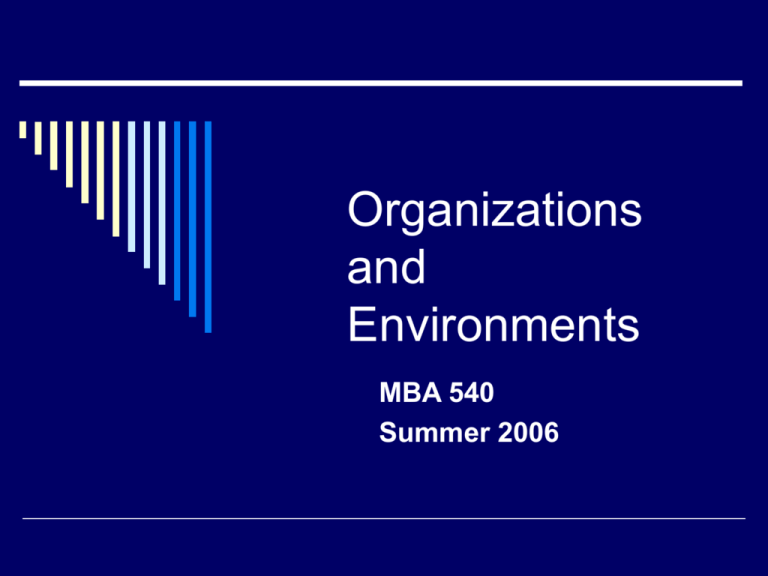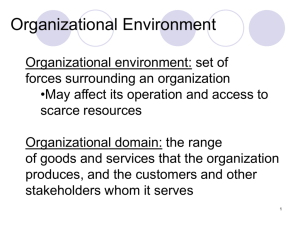Organizations and Environments
advertisement

Organizations and Environments MBA 540 Summer 2006 Essential Features of Organizations Open system: input, transformation, output Subsystems: boundary spanning, production, maintenance, adaptation, management Domains: range of products and services produced for serving markets and customers Environmental transactions: dealing with factors outside the organizational boundaries Open Systems View of Organization ENVIRONMENT Raw Materials Products Input Transformation Output Organization Resources Services Boundary Spanning Production Maintenance Adaptation Management Subsystems Boundary Spanning Let’s Consider Hasbro Toy industry's growth prospects appear to be maturing Increasing competition from video games, children's changing tastes, and consolidation of the industry's retail customer base. Toy companies are increasingly dependent on movies and TV shows for product tie-ins What are the major external challenges facing Hasbro? www.hasbro.com Changing Environments Environmental Change Environmental Complexity Resource Scarcity Uncertainty Environmental Change Environmental change is the rate at which a company’s environments change stable environments dynamic environments Punctuated equilibrium theory companies cycle through stable and dynamic environments Punctuated Equilibrium 3rd Revolutionary Period: Following September 11th terrorist attack. U.S. Airline Industry $15,000,000 Operating $10,000,000 1st Revolutionary Period: Deregulation of U.S. Airline Industry $5,000,000 -$5,000,000 Operating -$10,000,000 -$15,000,000 Year 2001 2000 1999 1998 1997 1996 1995 1994 1993 1992 1991 1990 1989 1988 1987 1986 1985 1984 1983 1982 1981 1980 1979 1978 1977 $0 1976 $ in Thousands Equilibrium: Followed by another period of industry stability. 2nd Revolutionary Period: Rising Cost of Jet Fuel and Employee Salaries and Benefits Equilibrium: Followed by a period of industry stability. Environmental Complexity Environmental complexity: the number of external factors in the environment that affect organizations Simple environments have few environmental factors Example? Complex environments have many environmental factors Example? Environmental Uncertainty Simple -Complex Dimension Number of elements and their similarity Family restaurant vs. automobile manufacturer Determines what information you need Stability-Change Dimension how fast and unpredictably elements change Universities vs. telecommunications Determines how often you need to collect information Environmental Uncertainty Rate of Change Low High Low Complexity High Low Uncertainty (Information known and available) Moderate Uncertainty (Information overload) Moderate Uncertainty (Constantly need new information) High Uncertainty (Information needs unknown) Resource Scarcity Resource scarcity (vs. munificence) is the degree to which an organization’s external environment has an abundance or scarcity of critical organizational resources Environmental Uncertainty Uncertainty is how well managers can understand or predict the external changes and trends affecting their businesses More Complexity + More Change + Scarcer Resources More Uncertainty Types of Environmental Factors Organization Specific Environment General Environment Specific factors directly impinge on particular organization General factors affect all companies within an industry Organization-Environment Interface Task (specific) factors General factors Customers Suppliers Distributors Regulatory agencies Competitors Unions Partners Special Interest Groups Economic International Political/legal Technology Demographic Cultural/social Physical/natural resources Example: Home Depot Theories of OrganizationEnvironment Relationships Contingency Theory Resource Dependence Strategic Choice Population Ecology Institutional Theory Transaction Cost Theory Contingency Theory Most effective way to organize is contingent on complexity and change in environment Stable environments: Mechanistic structures (specialization, formality, hierarchy) Changing environments: Organic structures (less specialization, informality, lateral relations) Resource Dependence • • • • Organizations obtain scarce and valued resources from environments Desire to control these resources to minimize dependencies Processes and transactions used to obtain resources develop dependencies Balancing act of maintaining autonomy and recognizing dependencies Strategic choice • • • • • • Managers perceive environments Make strategy and design structure Re-strategize when changes are perceived Managers enact environments through their decision-making choices Since managers perceive differently, they bring organizations in different directions Example: Sears vs. Montgomery Ward Population Ecology Focus is on whole population of organizations (e.g., gasoline stations in Canada; wine industry in California) Natural selection processes: Variation Selection Retention Unsuccessful organizational forms die out Environmental determinism Institutional Theory • • • • • Societal institutions are powerful forces for ensuring control and order In responding to institutional pressures, organizations develop isomorphic (similar) strategies, structures, and systems Normative, coercive, and mimetic forces make “all organizations look the same” Goal is to obtain social legitimacy Example: banks, universities, discount stores Transaction Cost Theory Organizations try to reduce monitoring, negotiating, and governing exchanges with environmental elements (transaction costs) Environmental uncertainty, opportunism, bounded rationality, small numbers bargaining, asset specificity, and risk levels increase transaction costs Transaction and bureaucratic costs balanced What specific adaptation devices do organizations use? Structural Responses Develop new positions or units Boundary-spanning activities Buffering roles and units Planning Groups Forecasting Management Information Systems Specific Adaptation Devices Inter-organizational Linkages: Symbiotic interdependencies Benefit both organizations Competitive interdependencies Direct competition for scarce resources Symbiotic Interdependencies Good reputation Cooptation Interlocking directorates Strategic alliances Long-term Contracts Equity ownership in other firms Joint ventures Mergers, acquisitions, and takeovers Licensing Consortia Marketing or distribution agreements Franchising Competitive Interdependencies Collusions Regulatory bodies Signaling Competitive strategic Cartels alliances Networking Trade associations









